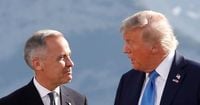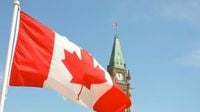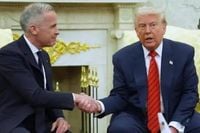Canadian Prime Minister Mark Carney is poised to step into the Oval Office on Tuesday, October 7, 2025, for a high-stakes meeting with U.S. President Donald Trump, as the two leaders seek to navigate one of the most turbulent periods in modern Canada-U.S. relations. The summit, described by Carney's office as a "working visit," comes at a critical juncture for the North American neighbors, whose economic and security ties are being tested by escalating trade tensions, sector-specific tariffs, and even talk of annexation.
According to AP, Carney will travel to Washington on Monday, October 6, before his face-to-face meeting with Trump the following day. The agenda, as outlined in statements from both governments, will center on "shared priorities in a new economic and security relationship between Canada and the U.S." The timing is significant: both countries are gearing up for the first joint review of the United States-Mexico-Canada Agreement (USMCA), the trade pact that has defined North American commerce since 2020 and is set for formal reassessment in 2026.
This will be Carney’s second trip to the White House since his election in April, underscoring the urgency of the moment. Trade tensions, triggered by the Trump administration’s aggressive tariff strategy, have cast a long shadow over bilateral relations. As Reuters notes, Canada has been holding talks with the U.S. for months, aiming to remove all tariffs on Canadian goods—a goal that has so far proven elusive.
The economic fallout north of the border has been severe. Canada’s GDP contracted by about 1.5% in the second quarter of 2025, with exports plunging a staggering 27%, according to government data cited by Reuters. The pain has been most acute in sectors targeted by U.S. tariffs—autos, steel, aluminum, and lumber—forcing Carney’s government to announce billions of dollars in support for struggling industries.
President Trump’s rationale for the tariffs has evolved over time, but recently he has pointed to Canada’s perceived failure to stem the flow of fentanyl into the U.S. Carney has pushed back, insisting that Canada has "put a significant amount of resources toward stemming the flow of illicit drugs to the U.S.," as reported by AP. Still, the 35% general tariff the U.S. has slapped on some Canadian goods stands out as one of the highest rates imposed on any close American trading partner.
Yet, not all is doom and gloom. Thanks to the USMCA, roughly 85% of Canada’s trade with the U.S. remains tariff-free, and Carney’s office has been quick to point out that Canada "has the lowest average tariff rate of any American trading partner." Products that are wholly manufactured in North America, or meet specific regional content requirements, continue to move across the border without added duties. In May, about 90% of Canada’s exports to the U.S. enjoyed these exemptions, according to AP.
However, the sectors not covered by USMCA—most notably steel, aluminum, autos, and lumber—have been hit especially hard. Trump’s administration recently imposed a 10% tariff on Canadian softwood lumber, bringing the total tariff level on that product to just over 45%, as reported by The New York Times. The ripple effects have been felt in layoffs, plant closures, and mounting political pressure at home for Carney to secure relief.
Carney’s strategy has been one of cautious pragmatism. He has made several concessions to the U.S., including canceling a tax on American technology companies (a move that had prompted Trump to suspend trade talks) and withdrawing many of the retaliatory tariffs imposed by the previous Canadian government. As The New York Times highlights, critics in Canada have accused Carney of being too conciliatory, with the opposition charging that he has failed to extract meaningful concessions from Trump in return.
Carney, for his part, has sought to diversify Canada’s trade portfolio. Just last month, he traveled to Mexico City to meet with President Claudia Sheinbaum, hoping to expand ties with other USMCA partners. But with more than 75% of Canada’s exports still destined for the U.S., and nearly $3.6 billion Canadian (US$2.7 billion) worth of goods and services crossing the border each day, the U.S. relationship remains paramount.
The stakes are high for both leaders. Trump has made clear his desire to renegotiate USMCA to "secure more favorable conditions for U.S. manufacturers," as noted by Reuters. He’s also floated the idea of Canada joining the U.S. as the 51st state—a suggestion that, while widely dismissed in Canada, has become a recurring theme in Trump’s rhetoric. “They want to be a part of it,” Trump said recently about his proposed "Golden Dome" missile defense program. “I said, ‘Why don’t you just join our country, become the 51st state and you get it for free.’”
Canadian officials, including Carney, have privately and publicly bristled at such talk. According to AP, Carney asked Trump to stop referring to Canada as the 51st state during their last White House meeting in May. The political risks for Carney are real: as Daniel Béland, a political science professor at McGill University, told AP, “A key political risk is that President Trump raises the 51st state issue again and seeks to publicly embarrass Prime Minister Carney during his visit.”
Despite the frosty atmosphere, there are glimmers of optimism. Canada’s top trade negotiator, Dominic LeBlanc, told a parliamentary committee that he is “not seeing a dead end” in talks on steel, aluminum, and auto tariffs. “We are confident that the domestic pressure from senators, governors, business leaders, union leaders, in the United States will also create potentially an opportunity for us to come to an agreement with the American administration,” LeBlanc said, as quoted by AP.
Meanwhile, Carney has reiterated that “Canada and the U.S. have now reestablished free trade for the vast majority of our goods.” He added, “Canada currently has the best trade deal with the United States. And while it’s different from what we had before, it’s still better than that of any other country.”
As the two leaders prepare to meet, both sides are launching consultations to inform preparations for the first joint USMCA review. The outcome of Tuesday’s talks could set the tone for North American trade for years to come. With so much at stake—jobs, industries, and the broader strategic partnership—Carney and Trump will need to find common ground, or risk deepening a rift that neither country can afford.
Tuesday’s meeting may not resolve every dispute, but it will be a pivotal moment in the ongoing saga of Canada-U.S. relations. The world will be watching to see whether pragmatism or politics wins the day.


